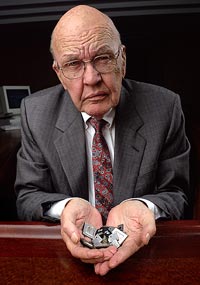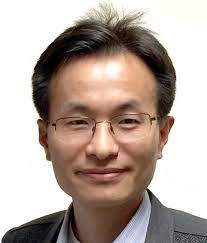Related Research Articles

John Bardeen was an American physicist and electrical engineer. He is the only person to be awarded the Nobel Prize in Physics twice: first in 1956 with William Shockley and Walter Brattain for the invention of the transistor; and again in 1972 with Leon N. Cooper and John Robert Schrieffer for a fundamental theory of conventional superconductivity known as the BCS theory.

Jack St. Clair Kilby was an American electrical engineer who took part, along with Robert Noyce of Fairchild Semiconductor, in the realization of the first integrated circuit while working at Texas Instruments (TI) in 1958. He was awarded the Nobel Prize in Physics on 10 December 2000.

John Bennett Fenn was an American professor of analytical chemistry who was awarded a share of the Nobel Prize in Chemistry in 2002. Fenn shared half of the award with Koichi Tanaka for their work in mass spectrometry. The other half of the 2002 award went to Kurt Wüthrich. Fenn's contributions specifically related to the development of electrospray ionization, now a commonly used technique for large molecules and routine liquid chromatography-tandem mass spectrometry. Early in his career, Fenn did research in the field of jet propulsion at Project SQUID, and focused on molecular beam studies. Fenn finished his career with more than 100 publications, including one book.

Koichi Tanaka is a Japanese electrical engineer who shared the Nobel Prize in Chemistry in 2002 for developing a novel method for mass spectrometric analyses of biological macromolecules with John Bennett Fenn and Kurt Wüthrich.

Aaron Ciechanover is an Israeli biologist who won the Nobel Prize in Chemistry for characterizing the method that cells use to degrade and recycle proteins using ubiquitin.
Craig Jon Hawker is an Australian-born chemist. His research has focused on the interface between organic and polymer chemistry, with emphasis on the design, synthesis, and application of well-defined macromolecular structures in biotechnology, microelectronics, and surface science. Hawker holds more than 45 U.S. patents, and he has co-authored over 300 papers in the areas of nanotechnology, materials science, and chemistry. He was listed as one of the top 100 most cited chemists worldwide over the decade 1992–2002, and again in 2000–2010.

Henry Frederick "Fritz" Schaefer III is an American computational, physical, and theoretical chemist. He is one of the most highly cited chemists in the world, with a Thomson Reuters h-index of 121 as of 2020.
Ralph Edward Gomory is an American applied mathematician and executive. Gomory worked at IBM as a researcher and later as an executive. During that time, his research led to the creation of new areas of applied mathematics.

George McClelland Whitesides is an American chemist and professor of chemistry at Harvard University. He is best known for his work in the areas of nuclear magnetic resonance spectroscopy, organometallic chemistry, molecular self-assembly, soft lithography, microfabrication, microfluidics, and nanotechnology. A prolific author and patent holder who has received many awards, he received the highest Hirsch index rating of all living chemists in 2011.

Krzysztof "Kris" Matyjaszewski is a Polish-American chemist. He is the J.C. Warner Professor of the Natural Sciences at the Carnegie Mellon University Matyjaszewski is best known for the discovery of atom transfer radical polymerization (ATRP), a novel method of polymer synthesis that has revolutionized the way macromolecules are made.
Octavio Augusto Novaro Peñalosa was a prominent theoretical physicist specialized in theoretical catalysis, physical chemistry, biophysics and geophysics. He received the National Prize for Arts and Sciences in 1983 and became the first Mexican researcher to receive the UNESCO Science Prize in 1993. Since 1995 he was also one of the forty lifetime members of The National College.
Willem P. C. "Pim" Stemmer was a Dutch scientist and entrepreneur who invented numerous biotechnologies. He was the founder and CEO of Amunix Inc., a company that creates "pharmaceutical proteins with extended dosing frequency". His other prominent inventions include DNA shuffling, now referred to as molecular breeding. He holds more than 97 patents. Stemmer was honored with the Charles Stark Draper Prize in 2011 for the pioneering contributions to directed evolution which won the Nobel Prize in Chemistry in 2018. He was elected as member of National Academy of Engineering.

Paul T. Anastas is an American scientist, inventor, author, entrepreneur, professor, and public servant. He is the Director of Yale University's Center for Green Chemistry and Green Engineering, Previously he served as the Science Advisor to the United States Environmental Protection Agency as well as the Agency's Assistant Administrator for Research and Development, appointed by President Barack Obama.

Akira Yoshino is a Japanese chemist. He is a fellow of Asahi Kasei Corporation and a professor at Meijo University in Nagoya. He created the first safe, production-viable lithium-ion battery, which became used widely in cellular phones and notebook computers. Yoshino was awarded the Nobel Prize in Chemistry in 2019 alongside M. Stanley Whittingham and John B. Goodenough.

Peidong Yang is a Chinese–American chemist, material scientist, and businessman. He is currently a professor at the University of California, Berkeley and a member of the American Academy of Arts and Sciences. He is a Professor of Chemistry and a Professor of Materials Science. His research group studies the synthesis of nanomaterials and their electronic and optical properties. He is also a Department Head at the Joint Center for Artificial Photosynthesis, Senior Faculty Scientist at Lawrence Berkeley National Laboratory, and Deputy Director of the Center of Integrated Nanomechanical Systems (COINS). He is an associate editor of the Journal of the American Chemical Society, an American Chemical Society Journal.

Prof. Dr. Avel·lí Corma i Canós is a Valencian (Spain) chemist distinguished for his world-leading work on heterogeneous catalysis.

Ganapati Dadasaheb Yadav is an Indian chemical engineer, inventor and academic, known for his research on nanomaterials, gas absorption with chemical reaction and phase transfer catalysis. He served as the vice chancellor of the Institute of Chemical Technology, Mumbai from 2009 until November 2019. He is currently the Emeritus Professor of Eminence at ICT Mumbai.
Paramasivam Natarajan (1940–2016) was an Indian photochemist, the INSA Senior Scientist at the National Centre for Ultrafast Process of the University of Madras and the director of Central Salt and Marine Chemicals Research Institute (CSMCRI) of the Council of Scientific and Industrial Research. He was known for his research on photochemistry of co-ordination compounds and macromolecular dye coatings for stabilization of electrodes. He was an elected fellow of the Indian National Science Academy, International Union of Pure and Applied Chemistry (IUPAC) and the Indian Academy of Sciences. The Council of Scientific and Industrial Research, the apex agency of the Government of India for scientific research, awarded him the Shanti Swarup Bhatnagar Prize for Science and Technology, one of the highest Indian science awards, in 1984, for his contributions to chemical sciences.
Swapan Kumar Pati is an Indian quantum chemist, a professor of the department of chemistry at the Jawaharlal Nehru Centre for Advanced Scientific Research and the head of the Quantum Theory Molecules to Materials Group at the institute. He is known for his studies on electronic optical and magnetic phenomena in molecular systems and is an elected fellow of the Indian Academy of Sciences, National Academy of Sciences, India and The World Academy of Sciences. The Council of Scientific and Industrial Research, the apex agency of the Government of India for scientific research, awarded him the Shanti Swarup Bhatnagar Prize for Science and Technology, one of the highest Indian science awards, in 2010, for his contributions to chemical sciences.
John Ralph is a New Zealand-born, American chemist, wood scientist, and professor at the University of Wisconsin-Madison. He is an elected fellow (FIAWS) of the International Academy of Wood Science and the American Association for the Advancement of Science (FAAAS).
References
- ↑ "USPTO Patent Full-Text and Image Database". United States Patent and Trademark Office. Archived from the original on 2018-10-05. Retrieved 2008-04-06.
- ↑ "Detecting the presence of failure(s) in existing man-made structures". Freepatentsonline. Retrieved 2008-04-06.
- ↑ "Google Scholar" . Retrieved 2008-04-06.
- ↑ "NACS - History of Catalysis". Archived from the original on 2008-04-18. Retrieved 2008-09-15.